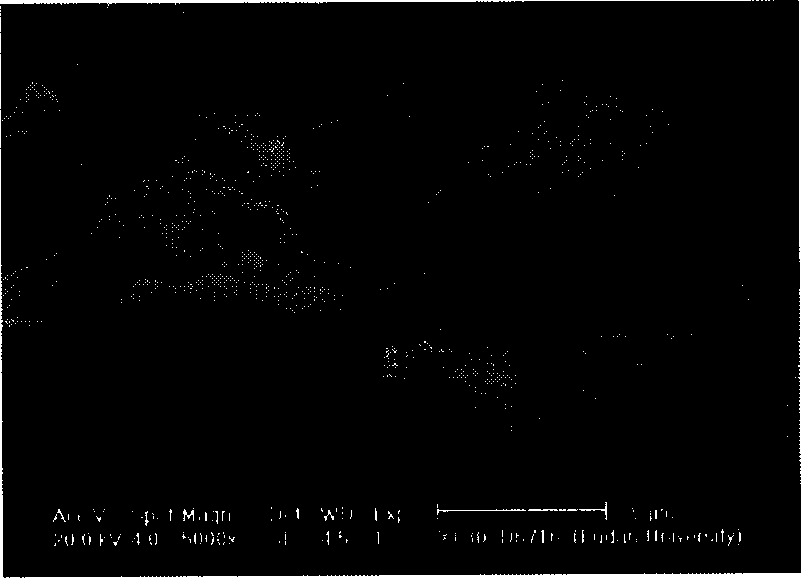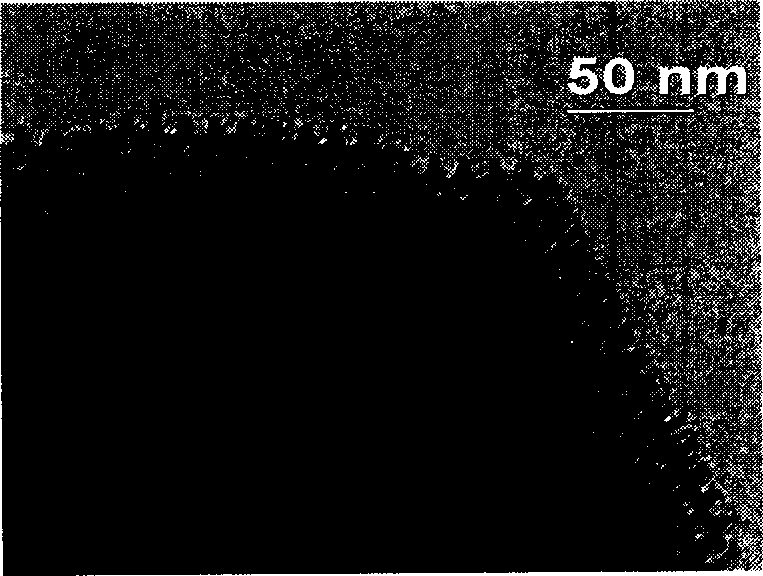Molecular sieve catalyst containing pores in tungsten media utilized for synthesizing glutaraldehyde and its preparation method
A technology for synthesizing glutaraldehyde and mesoporous molecular sieve, applied in molecular sieve catalysts, chemical instruments and methods, physical/chemical process catalysts, etc., can solve the difficulty of separating catalysts from products, the production capacity is less than 500 tons, and the yield of glutaraldehyde is less than 500 tons. It can achieve the effect of excellent catalytic performance, insensitive reaction parameters, and easy production control.
- Summary
- Abstract
- Description
- Claims
- Application Information
AI Technical Summary
Problems solved by technology
Method used
Image
Examples
Embodiment 1
[0022] Example 1: 40°C oil bath, electromagnetic stirring, 60 mL of concentrated hydrochloric acid was added into 312 mL of deionized water containing 0.3 g of template agent P123 (molecular weight: 5800), and stirred for 4 hours. Add 25.6 g of ethyl orthosilicate, stir for 1 hour, add 10 mL of aqueous solution containing 0.495 g of phosphotungstic acid, and continue stirring for 24 hours. Transfer the obtained colloid into a 1000mL autoclave and seal it, and take it out after crystallization at 100°C for 72 hours; filter, wash with water, and bake at 100°C for 24 hours. Calcined in an oxygen atmosphere at 700°C for more than 6 hours, granulated, sieved with 40-60 meshes, and activated at 800°C for 3 hours to obtain catalyst #1.
Embodiment 2
[0023] Example 2: In an oil bath at 35°C, with mechanical stirring, 90 mL of concentrated hydrochloric acid was added into 468 mL of deionized water containing 0.5 g of template agent P123 (molecular weight: 5800), and stirred for 6 hours. Add 25.6g ethyl orthosilicate, stir for 2 hours, add 10mL aqueous solution containing 1.05g ammonium tungstate, and continue stirring for 36 hours. Transfer the obtained colloid into a 1000mL autoclave and seal it, and take it out after crystallization at 100°C for 48 hours; the remainder is the same as in Example 1 to obtain 2# catalyst.
Embodiment 3
[0024] Example 3: 50° C. oil bath, electromagnetic stirring, 45 mL of concentrated hydrochloric acid was added into 208 mL of deionized water containing 0.4 g of template agent P123 (molecular weight: 5800), and stirred for 3 hours. Add 25.6g ethyl orthosilicate, stir for 1.5 hours, add 10mL aqueous solution containing 2.15g sodium tungstate, and continue stirring for 48 hours. Transfer the obtained colloid into a 500mL autoclave and seal it, and take it out after crystallization at 100°C for 96 hours; the remainder is the same as in Example 1 to obtain 3# catalyst.
PUM
 Login to View More
Login to View More Abstract
Description
Claims
Application Information
 Login to View More
Login to View More - R&D
- Intellectual Property
- Life Sciences
- Materials
- Tech Scout
- Unparalleled Data Quality
- Higher Quality Content
- 60% Fewer Hallucinations
Browse by: Latest US Patents, China's latest patents, Technical Efficacy Thesaurus, Application Domain, Technology Topic, Popular Technical Reports.
© 2025 PatSnap. All rights reserved.Legal|Privacy policy|Modern Slavery Act Transparency Statement|Sitemap|About US| Contact US: help@patsnap.com


